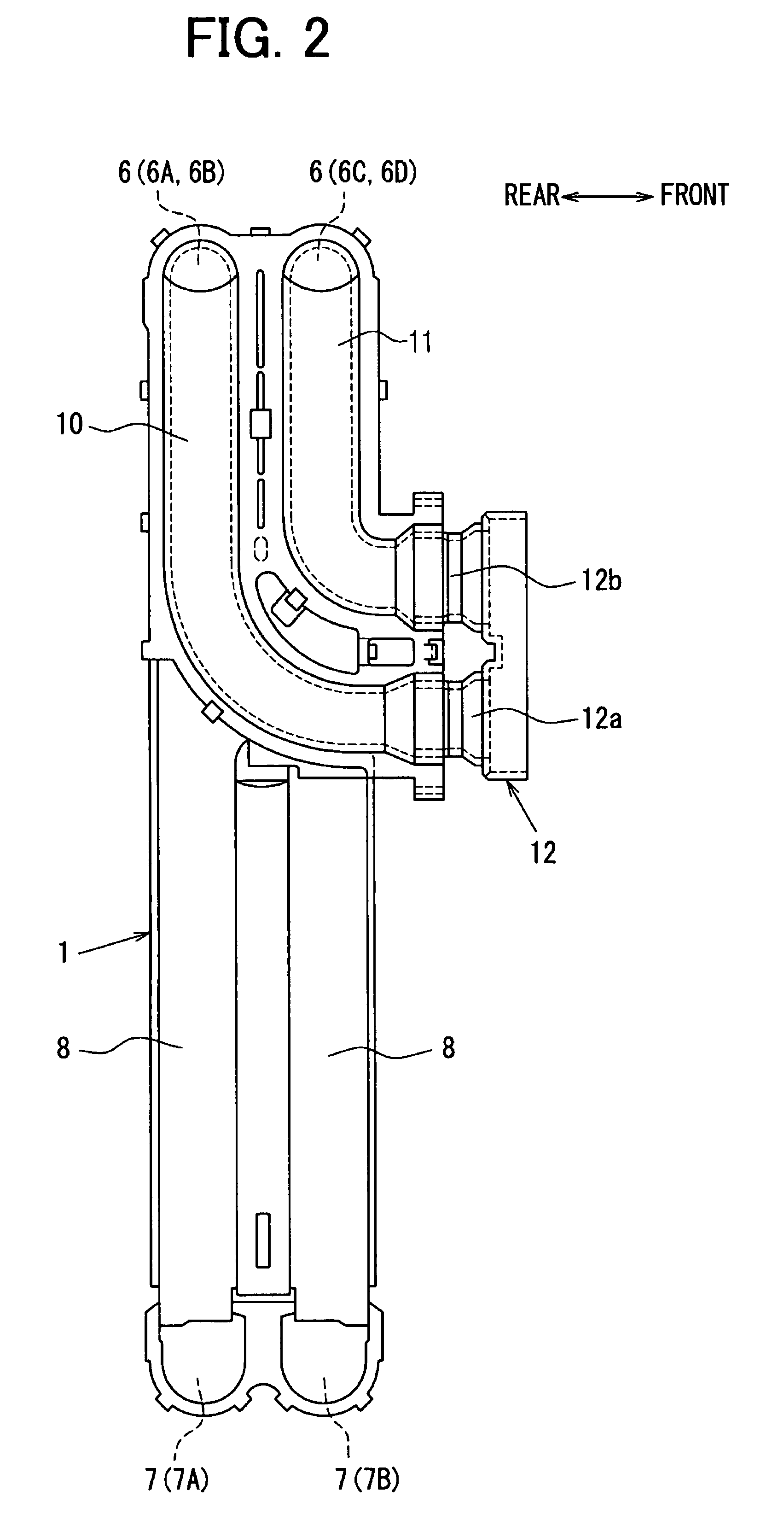Heat exchanger pipe joint
a technology of heat exchanger and pipe joint, which is applied in the direction of hose connection, indirect heat exchanger, light and heating apparatus, etc., can solve the problems of deteriorating interim storage capacity poor transportability increase in processing costs in the connection step of the manufacturing of the heat exchanger, so as to reduce the effect of processing cos
- Summary
- Abstract
- Description
- Claims
- Application Information
AI Technical Summary
Benefits of technology
Problems solved by technology
Method used
Image
Examples
first embodiment
[0031]A first embodiment of the present invention will be now described with reference to FIGS. 1 to 5D.
[0032]FIG. 1 is a partial sectional view showing a schematic structure of an evaporator 1 according to the first embodiment. As shown in FIG. 1, an evaporator 1 which is an example of a heat exchanger is constructed of a core portion 2 including tubes 3 and fins 4 which are alternately laminated, an upper tank 6 and a lower tank 7 disposed on upper and lower ends of the core portion 2, and side plates 8 supporting the fins 4 at both ends of the core portion 2. An inlet side refrigerant flow path 10 is connected to an inlet portion 61 of the upper tank 6, while being adjacent to one side plate 8. An outlet side refrigerant flow path 11 is connected to an outlet portion 62. A socket 12 is connected to connect ends of these refrigerant flow paths 10, 11.
[0033]The evaporator 1 is constructed of an arrangement of two lines in a front and rear direction (see FIG. 2), each line consistin...
second embodiment
[0080]A second embodiment of the present invention will be now described with reference to FIGS. 6A to 6C.
[0081]In the second embodiment, in order to improve the corrosion protection property of the seal surfaces of the O-rings 16, 17, a sacrificial corrosive material 13c is formed to be positioned in the vicinity of the seal surfaces of the O-rings 16, 17. That is, by providing the sacrificial corrosive material 13c in the vicinity of the connection plate 13, the corrosion protection property of the seal surfaces of the O-rings 16, 17 is improved, at a position on which the outer peripheral edges of the O-rings 16, 17 abut against the inner peripheral edges of the second inner circumferential portions 123a, 123b formed in the socket 12.
[0082]First, as shown in FIG. 6A, the sacrificial corrosive material 13c is integrally formed with the connection plate 13 at one end surface side at which the O-rings 16, 17 of the connection plate 13 are disposed. In other words, the connection pla...
third embodiment
[0088]A third embodiment of the present invention will be now described with reference to FIGS. 7A to 8.
[0089]Although in the above-described embodiments, the plurality of drain holes 128 are formed in the root (lower end part) of the connection portion 121 of the socket 12 so as to discharge the condensed water entering the socket 12, drain holes 138a to 138f may be formed in the connection plate 13. In this case, as shown in FIGS. 7A to 7F, the drain holes 138a to 138f can be formed at different positions.
[0090]When the socket 12 and the connection plate 13 are disposed vertically or in the up-down direction (top-bottom direction in FIG. 7A) such that the inlet pipe 14 and the outlet pipe 15 are arranged in the upper-down direction, that is, in the direction of gravity, as shown in FIG. 7A, the drain holes 138a, 138b may be formed on the upper and lower ends of the connection plate 13. That is, the drain holes 138a, 138b may be provided at least on the uppermost and lowermost part...
PUM
| Property | Measurement | Unit |
|---|---|---|
| radial dimension | aaaaa | aaaaa |
| corrosive | aaaaa | aaaaa |
| gravity | aaaaa | aaaaa |
Abstract
Description
Claims
Application Information
 Login to View More
Login to View More - R&D
- Intellectual Property
- Life Sciences
- Materials
- Tech Scout
- Unparalleled Data Quality
- Higher Quality Content
- 60% Fewer Hallucinations
Browse by: Latest US Patents, China's latest patents, Technical Efficacy Thesaurus, Application Domain, Technology Topic, Popular Technical Reports.
© 2025 PatSnap. All rights reserved.Legal|Privacy policy|Modern Slavery Act Transparency Statement|Sitemap|About US| Contact US: help@patsnap.com



